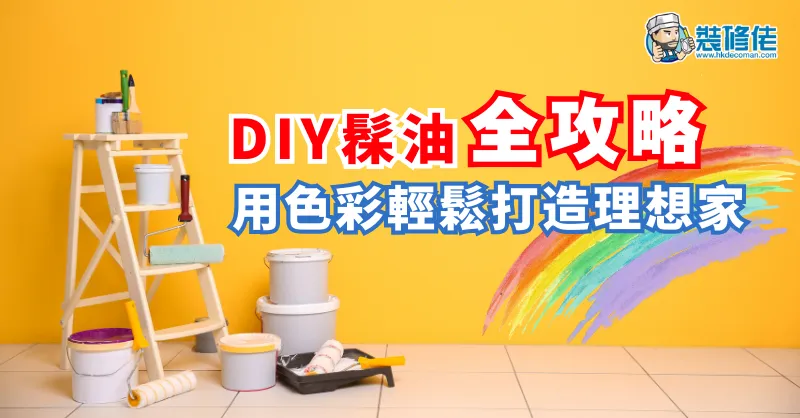DIY Painting: A Step-by-Step Guide
Listen to the blog audio:

With the rise of the DIY culture, more and more people are choosing to paint their homes themselves. Not only does doing it yourself save on renovation costs, but you can also choose paint products that suit your personal preferences and needs, and freely select shades to showcase your personal style. By participating, you can experience the fun of painting and pick up the relevant skills, giving your home a refreshing new look. This time, the renovation guys will share a complete DIY painting guide.
Painting Steps:
Preparation:
- Clean the work area and remove any furniture that may hinder the work.
- Use masking tape to protect areas that do not need to be painted, such as the skirting boards, and use masking paper to cover furniture and floors.
Basic Tool Preparation:
- For large areas: Paint roller, paint tray, and extension pole.
- For detail work: Paintbrush, small paint bucket.
- Auxiliary tools: Paint stirrer, measuring cup, sandpaper, putty knife, dust sheet.
- Safety equipment: Face mask, gloves, safety goggles.
Paint Preparation:
- Paint remover/wall scraper.
- Clear coat or sealer.
- Waterproof primer (if needed)
- Wall putty.
- Undercoat.
- Topcoat (latex paint/artistic paint)
Steps:
- Wall surface cleaning: Use paint remover to scrape off old paint. If the wall is deteriorated, remove the base coat and loose wall surface (scrape the base).
- Moisture-proof sealing: Apply a clear coat or sealer and let it dry thoroughly.
- Plastering and patching: Use wall putty to fill in cracks and indentations, then smooth with sandpaper.
- Undercoat application: Apply a uniform layer and wait for it to dry completely.
- Topcoat application: It is recommended to apply at least two coats, allowing each layer to dry thoroughly in between.

The Importance of Undercoat and Topcoat
In the paint coating system, the undercoat and topcoat play different but equally important roles. The undercoat serves as the first line of defense, improving the adhesion of the topcoat while also preventing the wall from getting damp, creating the perfect foundation for the subsequent topcoat application. The topcoat, on the other hand, is the outer layer that delivers the desired decorative effect, such as different shades or textures, giving the home a completely new feel. Moreover, the topcoat needs to have the ability to resist environmental factors. For instance, adding special functions like anti-moisture, anti-bacterial, and anti-stain to interior wall paint ensures the durability of the paint film while also making the living environment healthier and more aesthetically pleasing.

Versatile Functions of Paint
Paint technology has made great strides, and paint products on the market today are no longer limited to basic decorative purposes. They now incorporate a variety of practical functions to meet different living needs. As modern people pay more attention to health and environmental protection, zero-VOC paints that are environmentally friendly and odorless can be found on the market. These paints also have the function of decomposing formaldehyde to continuously improve indoor air quality. The moisture-proof, mildew-proof, antibacterial, and antiviral properties are especially suitable for users who care about cleanliness and hygiene. In a nutshell, different spaces can fully utilize the protective and practical functions of paint by choosing the right features according to their needs. For example, damp spaces should be painted with moisture-proof and mildew-proof paint, while the living room or children's room can be painted with stain-resistant paint for easy cleaning. As for the master bedroom, you can choose an artistic paint with a unique texture to enhance the style and atmosphere.

Tips for Using Color Cards
Many people mistakenly believe that the paint color on the color card will exactly match the color when it's painted on the wall. This is a misconception. Due to factors such as light reflection, the color of the walls after painting is usually slightly darker than the color shown on the color card.
Choosing a Color: When selecting a color from the color card, it is best to choose a shade that is slightly lighter than your desired color.
Color Variation: It is recommended to obtain a physical color card for an accurate comparison, as lighting can affect the color presentation. Also, to avoid screen color differences, it is not recommended to rely solely on electronic color cards. Be sure to check the actual color card before making a purchase.

Tool Purchasing Guide
When visiting a color center, in addition to using color cards to choose your favorite colors, remember to also equip yourself with the appropriate tools for the job:
For Regular Latex Paint: It is recommended to purchase paint rollers, brushes, and trays.
For Artistic Paint: Specialized tools are required to achieve the desired textured effect.
Friendly Reminder: If you are unsure about which tools you need, feel free to ask the staff at the color center. They will be able to suggest the appropriate set of tools based on the type of paint you are purchasing and the area you plan to paint.

One-Stop Solution for a Peace of Mind at Home
We understand the high standards modern families have for their living environments, which is why we highly recommend the all-around "Nippon Anti-Formaldehyde Odour-less Child-Friendly Paint Series". It not only allows homeowners to DIY and create their dream home aesthetics but also achieves a zero-pollution living space, comprehensively safeguarding the health of your family*. Nippon Paint offers three high-quality child-friendly paint products to meet the diverse needs of different families.
*Nippon Anti-Virus Odour-less Child-Friendly Paint and Nippon Child-Friendly Paint Suede Effect Paint are certified by the American Green Guard (GREENGUARD Gold) and the US Food and Drug Administration (FDA).
Nippon Odour-less Child-Friendly Paint - Basic Guardian Type
The Child-Friendly Paint series emphasizes eco-friendliness and safety. It effectively decomposes formaldehyde and, with its odour-less zero-VOC formula, makes the indoor air fresher. It also has Grade 1 antibacterial (effective against 20 common bacteria and mould) and Grade 1 anti-dirt properties, along with superior mould-proof, anti-moisture, and breathable functions, making it an ideal choice for home renovation.

Nippon Anti-Virus Odour-less Child-Friendly Paint - Full Protective Type
Building on the basic functions, this paint adds advanced silver ion anti-virus technology, effectively fighting viruses such as Influenza A (H3N2) and Enterovirus 71 (EV71). With a Grade 1 antibacterial rate of up to 99.9%*, it can defend against 22 types of bacteria and mould, building a more comprehensive health protection network for your family.
*According to GB/T 21866-2008, the standard for "Antibacterial Test Method and Antibacterial Effect of Antibacterial Coatings (Films)".

Nippon Child-Friendly Paint Suede Effect Paint - Stylish Tasteful Type
Not only does it retain all the protective characteristics of the series, but it can also create various leather-textured effects using a dedicated roller and tools. The paint finish has an eggshell gloss, giving the walls a sense of depth and dimension. It is suitable for large-area painting and adds an artistic atmosphere to the space, enhancing your quality of life.

Nippon Paint - Rich Colour Expert
Nippon Paint now provides a convenient computer colour-matching service. Customers can choose their desired colours from the 1988 colour card, and through the store's exclusive colour machine's computer colour-matching technology, the paint colour mixing can be completed in just 5-10 minutes. This thoughtful service makes DIY renovation easier, allowing every user to effortlessly bring their dream colours into their homes and create unique living spaces.
Home DIY Colour Limited Offer
Want to start DIY but don't know where to begin with colour selection? How can you buy smartly?

Recently, the Nippon Paint online store also has a limited-time offer where you can purchase a Nippon Paint 368 Dream Color Card for just $20. This makes it easy to choose your favorite colors from the comfort of your home and create a personalized space. Hurry and shop now on HKTVmall! https://bit.ly/48ZjpcB
For more home color tips and information:
Nippon Paint website: https://bit.ly/4ghRiIt
Nippon Paint Facebook: https://www.facebook.com/nipponpainthongkong
Nippon Paint Instagram: https://www.instagram.com/nipponpainthk/
For free quotes on different types of home renovations, visit: 裝修報價
Public housing: https://decoman-publichousing.com/
Private apartments: https://decoman-privatehousing.com/
New properties: https://decoman-newproperties.com/
Tong Yang apartments: https://decoman-tenement.com/
===============================================
This article and its images are provided by 裝修佬.









